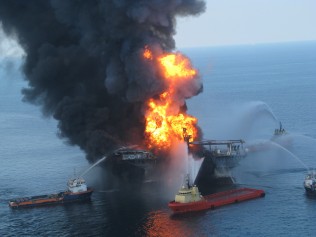
At the beginning of October, BP submitted new drilling plans to the National Offshore Petroleum Safety and Environmental Management Authority. These plans, according to sources, outline BP’s strategy for drilling the first of four exploratory wells off the South Australian coast beginning next year. While the Management Authority’s decision isn’t expected until later this month, officials are expressing concerns over the potential for environmental catastrophe in the event of an oil spill in the region.
According to new modeling commissioned by the Wilderness Society, a Gulf of Mexico-type spill in the Great Australian Bight could have tremendous impacts on a significant percentage of Australia’s southern coastline by shutting down fisheries and threatening populations of whales, sea lions, seabirds, and a host of other aquatic species in the region. The model predicts that a significant failure in BP’s deep sea drilling could result in more than 265,000 square kilometers of ocean to be contaminated by enough oil to warrant closing fisheries and compromising the region’s tourism industry.
Evaluating Likelihood of Various Scenarios
The analysis commissioned by the Wilderness Society offers a number of different scenarios, mostly depending on the size of the spill and the season in which the spill occurs. According to their analysis, even a “low-flow” spill, which was determined to be 5,000 barrels a day, would result in oil extending from Western Australia all the way to Victoria in the east.
The analysis also examined the range of oil contamination for a scenario in which 50,000 barrels a day were emptied into the ocean, which is actually slightly less than the devastating 2011 BP spill in the Gulf of Mexico. In this scenario, the model predicted that oil could stretch throughout the Bass Strait and that there was at least a ten percent chance of this oil reaching New Zealand.
The Wilderness Society’s model also looked at likely trajectories for a potential oil spread in the summer and winter months, respectively. Using prevailing ocean currents as a guide, the model predicted that a spill occurring in the summer would most likely have the greatest impact on whaling areas off the coast of Western Australia.
The model predicted that a spill occurring in the winter would most likely result in oil drifting towards Kangaroo Island, the Spencer Gulf, the Eyre Peninsula, and points further east. Interestingly, the model also suggested that, regardless of the season in which the spill occurs, there is a 70 to 80 percent chance that oil will reach Australia’s vast shoreline at levels up to 424 grams per square meter.
A Response from BP?
Although BP hasn’t yet provided a spill model, the company maintains that it will be able to plug any leak that occurs within 35 days. Meeting this guarantee, however, requires shipping and installing capping equipment all the way from Singapore, which is 4,800 kilometers from the proposed drilling location. According to Guardian Australia, BP would also need to bring a containment system from Houston, more than 8,700 miles away, in order to effectively plug a leak.
For a bit of perspective, it took BP an unacceptable 87 days to stem the leak in the Deepwater Horizon disaster in the Gulf of Mexico, an event that resulted in death for eleven people and thousands of marine animals. In addition, many officials believe that any recovery mission in the Great Australian Bight would ultimately prove much more difficult than what was required in the Gulf of Mexico, mainly due to the region’s strong winds and high seas.
Weighing Environmental and Economic Risk
Many environmental groups are naturally opposed to the drilling project because of the risk it poses to the region’s unique biodiversity. The Great Australian Bight is a natural breeding and feeding ground for a wide variety of marine species, including blue whales, southern right whales, great white sharks, sea lions, various seabirds, endangered loggerhead and leatherback sea turtles, and a host of other animals.
According to the Wilderness Society, an unexpected oil spill would also have disastrous effects on the region’s $1.2 billion dollar tourism industry, as well as the $442 million dollar fishing industry. These loses, of course, would only be multiplied if fisheries throughout the Bass Strait were required to shut down due to a severe spill.
“An oil spill in the Great Australian Bight from a deep-sea well blowout would be a disaster for fisheries, tourism and marine life,” says Peter Owen, the Wilderness Society’s South Australian director. “The damage would be irreversible. We don’t need a Gulf of Mexico disaster in the Great Australian Bight.”
Although BP officials insist that “in a worst case scenario oil would take several weeks to reach shore and the direction in which it could drift varies due to seasonal differences in current and wind direction,” and that “the environment plan contains an oil pollution emergency plan that details how in the unlikely event of a spill, BP will be able to stop it, recover oil and support rehabilitation,” it’s clear that the company’s track record hasn’t given Australian officials much reason to be confident in these reassurances.
If you’d like to learn more about the Wilderness Society’s campaign to prevent deep-sea drilling in the Great Australian Bight, be sure to check out their website to learn more and see how you can get involved today.
Read Ethical Traveler's Reprint Policy.
